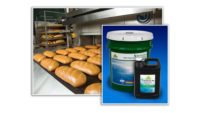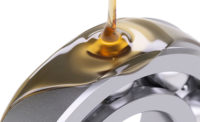Since 1998, food-grade lubricants haven’t been regulated by any government body. Is it time to reconsider global regulations and testing methods for mineral oil hydrocarbons?
That was the question posed by one of the speakers, Andre Adam of Fragol GmbH & Co. KG, at the recent European Lubricating Grease Institute’s annual meeting.
A lot is expected of food-grade lubricants. They must protect production equipment from wear and tear, lessen heat, work with rubber and other sealing materials, dissolve sugars and not be affected by food products, chemicals, water or steam, plastics or elastomers.
The United States Department of Agriculture (USDA) left in place food-grade designations of H1, H2 and H3 for lubricants: H1 lubricants are used in food-processing environments where there is the possibility of incidental food contact; H2 lubricants are used on equipment and machine parts in locations where there is no possibility of contact; and H3 lubricants are used to prevent rust on hooks, trolleys and similar equipment but are made of edible oils.
NSF International has evolved globally to succeed the USDA’s standards, and still certifies greases according to the previous guidelines.
“I don’t see any other government bodies stepping in any time soon to take this over for lubricants,” says Ashlee Breitner, business unit manager, NSF International’s Nonfood Compounds Program, based in Ann Arbor, Mich. “The main change with labeling that may come is the education of end users about what specific items on the product labels mean.”
For example, if a product is labeled H1 (incidental contact) or H2 (no food contact) registered, the manufacturer would educate consumers on the differences between the two claims.
NSF also offers an ingredient category designated as HX-1 for components and additives that have been pre-screened by NSF and determined to meet the formulary requirements for finished H1 lubricants.
“Using pre-approved HX-1 ingredients provides a unique solution for formulators by reducing the uncertainty of ingredient suitability,” says Breitner.
Additional registration categories exist for lubricants with special applications that may come into contact with food during use.
The HT-1 category was created for heat transfer fluids used in primary and secondary heating and cooling systems in food-processing facilities, says Breitner.
“Also many companies are currently changing their labels to comply with the two regulations in the EU CLP REGULATION (EC) No 1272/2008 and US OSHA Hazard Communication Standard (HCS),” says Breitner, which are required by June 1, 2015.
There is still concern in the industry that companies can label their greases in a misleading or confusing fashion, says Chuck Coe, president and principal consultant, Grease Technology Solutions LLC, based in Manassas, Va.
“The H1 label is not intended for consumers to think they can eat lubricants, just that there may be incidental food contact with the grease,” he says.
Delivering a better product
Food safety is certainly becoming a larger issue within the food-manufacturing sector and in the eyes of consumers. As this is occurring, food-grade lubricants have also taken on a new focus, as they are extremely important in the production of safe food.
“Lubricant manufacturers today are more readily using ingredients within their lubricants that comply with regulatory requirements to help them to ensure their safety of food-manufacturing applications,” says Breitner.
Coming to market are new food-grade lubricants that feature synthetic polyurea and calcium sulphate technology with H1 certification, notes Coe.
Synthetic polyurea greases aim to solve problems with high-temperature lubrication by resisting oxidation, along with water and corrosion resistance.
Calcium sulfonate thickeners, which are a more recent technology, can handle extreme pressure and be used in H1 applications, but can be relatively expensive compared to other thickener types.
“In my view, there’s no reason to say food-grade greases aren’t doing a good job,” says Coe. “The performance is there now, and the market is delivering a better product.”
The key is to get more components registered as HX-1, he says.
“Once the additives and thickeners are approved, more companies can make quality food-grade lubricants,” he says. As food production and processes change and evolve with new technologies, food-grade lubricants also have to evolve to meet the demanding needs of the technologies.
“Finding ingredients to manufacture food-grade lubricants that meet regulatory requirements but also the performance aspects of the manufacturing processes will continue to be an ongoing challenge for the lubricants industry,” says Breitner.
Regulations, by comparison
EU CLP Regulation 1272/2008 vs. OSHA Hazard Communication Standard transition periods
EU CLP Regulation 1272/2008
Substances
-
1st December 2010 – 1st June 2015
- Suppliers must classify substances according to both DSD and CLP. They must label and package according to CLP.
-
1st June 2015 onwards
- Suppliers must classify, label and package according to CLP.
Mixtures
-
20th January 2009 – 1st June 2015
- Suppliers must classify preparations according to DPD and may continue to label and package them according to DPD. However they may choose to classify, label and package mixtures according to CLP. In this case, CLP labeling must be used.
-
1st June 2015 onwards
- Suppliers must classify, label and package mixtures according to CLP.
OSHA Hazard Communication Standard (HCS)
Substances and Mixtures
-
1st December 2013
- Employees must be trained on the new label elements and safety data sheet (SDS) format before this date.
-
1st June 2015 onwards
- Suppliers shall classify, label and package chemicals according to the updated HCS (except distributors).
-
1st December 2015 onwards
- The distributor shall not ship containers labeled by the chemical manufacturer or importer unless it is a GHS label.
During the phase-in period, companies would be required to be in compliance with either the existing HCS or the revised HCS, or both. Employers are not required to maintain two sets of labels and SDSs for compliance purposes.





Report Abusive Comment